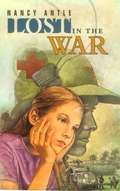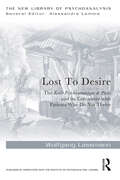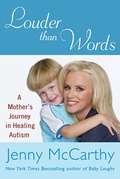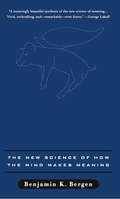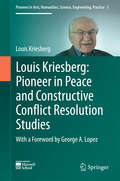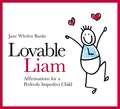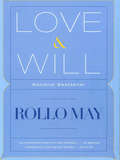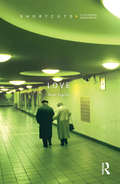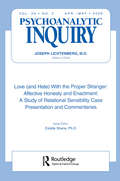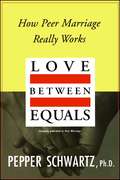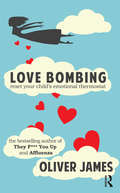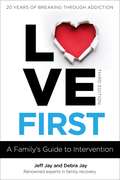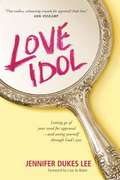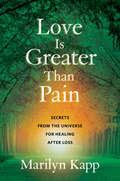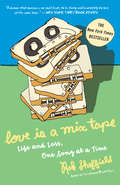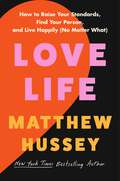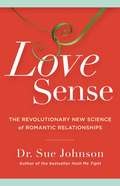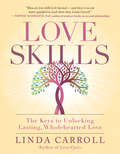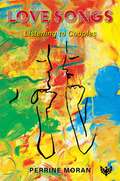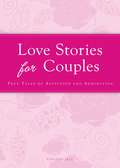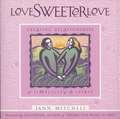- Table View
- List View
Lost in Trans Nation: A Child Psychiatrist's Guide Out of the Madness
by Miriam GrossmanThroughout our country, atrocities are taking place in doctor&’s offices and hospital operating rooms. Physically healthy children and adolescents are being permanently disfigured and sometimes sterilized. Those youth say they&’re transgender, and we—their parents, teachers, therapists, and doctors—are supposed to agree with their self-diagnosis and take a back seat as they make the most consequential decision of their lives: to alter their bodies in order to, we are told, &“align&” them with their minds. Medical, educational, and government authorities advise us to support the &“gender journeys&” of still developing kids, including medical interventions with poor evidence of long-term improvement. This would not be acceptable in any other field of medicine. Indeed, the treatments our medical authorities and Washington call &“crucial&” and &“life-saving&” have been banned in progressive Sweden, Finland, and Britain. Dr. Miriam Grossman is a child and adolescent psychiatrist whose practice consists of trans-identified youth and their families. In Lost in Trans Nation, she implores parents to reject the advice of gender experts and politicians and trust their guts—their parental instincts—in the face of an onslaught of ideologically driven misinformation that steers them and their children toward risky decisions they may end up mourning for the rest of their lives. The beliefs that male and female are human inventions; that the sex of a newborn is arbitrarily &“assigned&”; and that as a result the child requires &“affirmation&” through medical interventions—these ideas are divorced from reality and therefore hazardous, especially to children. The core belief—that biology can and should be denied—is a repudiation of reality and a mockery of what hard science teaches about being male and female. Dr. Grossman believes that parents know their child best; they especially know if they have a son or daughter. But currently in our country when it comes to gender identity, everyone knows better than mom and dad. Schools enable students to live double lives—Patrick at home, Patti at school. Activists tell kids their loving homes are &“unsafe&” when parents voice doubts about the child&’s new identity. For refusing to see their son as their daughter, parents might be reported to protective services, a development that can lead to a family&’s destruction. Lost in Trans Nation arms parents with the ammunition to avoid, or, if necessary, fight what many families describe as the most difficult challenge of their lives. Parents will learn what to say and how—at home, at school, and if necessary, to police when they appear at the door. &“Don&’t be blindsided like so many parents I know,&” warns Grossman, &“be proactive and get educated. Feel prepared and confident to discuss trans, nonbinary, or whatever your child brings to the dinner table.&” Whether it&’s the &“trans is as common as red hair&” claim, or the &“I&’m not your son, I&’m your daughter&” proclamation, or the &“do you prefer a live son or a dead daughter&’ threat, says Grossman, no family is immune, and every parent must be prepared. No child is born in the wrong body, Dr. Grossman reassures us, their bodies are just fine; it&’s their emotional lives that need healing. Whether you&’re facing a gender identity battle in your home right now, or want to prevent one, you need this book to guide you and your loved ones out of the madness.
Lost in Transmission: Studies of Trauma Across Generations
by M. Gerard FrommThis book is about how traumatic psychological injury is passed down to the children and grandchildren of those who originally experienced it and about finding the shared humanity in families, in psychotherapy, in society, and in memories of the past that repairs the damage people do to one another.
Lost in the War
by Nancy AntleTwelve-year-old Lisa Grey struggles to cope with a mother whose traumatic experiences as a nurse in Vietnam during the war are still haunting her.
Lost to Desire: The École Psychosomatique de Paris and its Encounter With Patients Who Do Not Thrive (New Library of Psychoanalysis)
by Wolfgang LassmannThis book covers the work of psychoanalysts in post WWII France with patients beset by somatic problems with little manifest fantasy life, and how their concept of opératoire continues to inform the theory and practice of working with patients in crisis. The author explores what the new concept has elicited in a community of practitioners – close to the École Psychosomatique de Paris – over a period of some sixty years. As a 'skin for thought' it facilitated change while preserving coherence, gradually beginning to attract further considerations. Important themes have included: the early groundwork necessary for the configuration of fantasy, the importance of a shared imaginary, the role of denial and obliterated memories as a bond between people, emergency measures of a Me cut off from revitalisation, the effects of the rhythms and atmosphere at the workplace on family life, and the consequences of a crisis suppressed for lack of a holding frame. As psychoanalytic discourse adapted to the challenges, the original perspective changed aspect, moving from a systematic evaluation of what the patients did not produce to what the analyst had to fill in to make sense of the situation. Clashing with the terrain, French psychoanalysts raised important problems about psychic anaemia that are stimulating and deserve cross-cultural discussion. This book will appeal to psychoanalysts in practice and training who wish to learn more about this ground-breaking work on memory and trauma, and how to apply it to their own practice.
Louder Than Words: A Mother's Journey into Healing Autism
by Jenny MccarthyThe author relates how she discovered a combination of behavioral therapy, diet and supplements that saved her son Evan from autism.
Louder Than Words: The New Science of How the Mind Makes Meaning
by Benjamin BergenWhether itOCOs brusque, convincing, fraught with emotion, or dripping with innuendo, language is fundamentally a tool for conveying meaningOCofor taking thoughts in the mind of one human being, and summoning similar thoughts in the mind of another. This is an amazing ability, one that is both uniquely and universally human. Yet the science of meaning has lagged behind the other cognitive sciences. ThatOCOs because, as human behaviors go, meaning is comparatively hard to study scientifically. Meaning is internal, intimately personal, and almost entirely hidden. But methodological breakthroughs in the past decade have revolutionized the science of meaning. In "Louder Than Words," cognition expert Benjamin Bergen describes how cutting-edge techniques from experimental psychology and neuroscience have started to produce answers to the question of how we manage to convey meaning. Drawing from brain imaging research, behavioral experiments, and work with brain-damaged patients, Bergen proposes a new account of how meaning works. Namely, when we hear or read words and sentences, we engage parts of the brain that are used for perception and action to create internal, mental simulations of meaning. When you read that OC the gorilla has hairy kneecaps, OCO you canOCOt help but activate parts of your vision system that re-enact what it would be like to see the hairy kneecaps on a gorilla. When you read OC ThereOCOs no way you can touch your elbow to your ear, OCO you use parts of your motor system, which controls actions your body might perform, to run a mental simulation of what it would be like to try to touch your elbow you your ear. Simply put, the way we understand what other people are saying is by mentally recreating the scenes and events that we think theyOCOre describing. To the extent that our mental simulations match theirs (far from given ), we will succeed in understanding what they want to tell us. "Louder Than Words" will answer such questions as: OCo Why do people drive badly while talking on a cell phone? OCo How do we understand language about things weOCOve never seen before, like flying pigs or Jabberwockies? OCo Why do we move our hands and arms when we speak? And do those gestures help people understand us? OCo Why is it that computers can beat a grandmaster at chess but canOCOt process language as well as a five-year old? OCo Do people who speak different languages think differently? "Louder Than Words" is the first book to bring together linguistics, cognitive psychology, and neuroscience to tell the compelling new story of how meaning works. It is a rich account that will change how people read, write, speak, and listen.
Louis Kriesberg: Pioneer in Peace and Constructive Conflict Resolution Studies
by Louis KriesbergThe author of the book, Louis Kriesberg, provides an informative account of his career, tracing his discoveries, contributions, and setbacks as he sought to help achieve a more sustainable and just global peace. Although neither an autobiography nor a memoir, the author embeds the course of his work in the context of historical events and in the evolving fields of peace studies and conflict resolution. In addition, he discusses the interaction of those fields with major conflicts. His work contributes to ideas and practices in several areas of conflict studies, notably intractable conflicts and their transformation, reconciliation, conflict analysis, and waging conflicts constructively. The book includes seven previously published, exemplary pieces on these and other topics, a comprehensive list of his publications and several photos. A discussion of Kriesberg s work and its significance is provided by George A. Lopez, Professor of Peace Studies, University of Notre Dame. "
Lovable Liam: Affirmations for a Perfectly Imperfect Child
by Jane Whelen-BanksLiam is lovable even when he whines and won't eat his dinner. When people are cross with Liam, they still love him. Being cross will only last a minute. Love will last forever! All children require discipline and boundaries. They need to be taught manners, traditions, morality and social conduct. With all these constant lessons and corrections, children can sometimes be left feeling overly criticised or unloved. Lovable Liam takes a moment to honour a child for who he is. It reminds parents to let their child know they are wonderful and precious - deeply valued by friends and family, even when people are cross with them. Vibrant, colourful and lively, this book's positive messages and advice are ideal for young children wanting to understand how relationships work.
Love & Will
by Rollo May"An extraordinary book on sex and civilization....An important contribution to contemporary morality."--Newsweek The heart of man's dilemma, according to Rollo May, is the failure to understand the real meaning of love and will, their source and interrelation. Bringing fresh insight to these concepts, May shows how we can attain a deeper consciousness.
Love (Shortcuts)
by Tom InglisLove is a dominant theme in Western popular culture. It has become central to the meaning of everyday life, propagated through the media and the market. Being in love has become idealised. With the demise of institutional religion in the West, romantic love has become the dominant form of inner-worldly salvation. In Foucault’s terms, it has become a key component in the ‘arts of existence’ and the care of self. In this highly accessible introduction to love of all kinds, Tom Inglis gives a clear, concise picture of how love shapes, and is shaped by, society. How is romantic love linked to capitalism? What is the difference between romantic love and loving? How is love connected to separation, loss and grief? Inglis addresses all these questions, and looks at how today’s changing circumstances – globalisation, mobile lives and a new rugged individualism – have changed our perceptions of love and relationships. Love is an engaging, thoughtful introduction to the subject for students, academics and general readers alike.
Love (and Hate) With the Proper Stranger (and Hate) With the Proper Stranger (and Hate) With the Proper Stranger (and Hate) With the Proper Stranger: Affective Honesty and Enactment: Psychoanalytic Inquiry, 26.2
by Estelle ShaneThis issue of Psychoanalytic Inquiry follows a design that has achieved increasing popularity in today's pluralistic world of psychoanalytic theory and practice. Providing a case presentation that incorporates detailed process noted along with a number of discussions of that case taken from divergent theoretical perspectives that appeals to the clinican operating in a postmodern setting. By proposing alternative ideas to the reader, the reader is afforded an opportunity to conceptualize from his or her own perspective the approach most conducive to good analytic work for the particular patient he or she has envisioned from reading the material presented. Or the reader may discover that alternative views suggested in the discussions may be integrated, establishing a more textured, more complex vision of the analytic pair at work together, a process facilitated through application of a systems sensibility. The abiding lesson - that there is no one good way to do our work but, on the other hand, that not all ways are equally good - is put forward persuasively in this format.
Love 2.0: Creating Happiness and Health in Moments of Connection
by Barbara L. FredricksonWe all know love matters, but in this groundbreaking book positive emotions expert Barbara Fredrickson shows us how much. Even more than happiness and optimism, love holds the key to improving our mental and physical health as well as lengthening our lives. Using research from her own lab, Fredrickson redefines love not as a stable behemoth, but as micro-moments of connection between people--even strangers. She demonstrates that our capacity for experiencing love can be measured and strengthened in ways that improve our health and longevity. Finally, she introduces us to informal and formal practices to unlock love in our lives, generate compassion, and even self-soothe. Rare in its scope and ambitious in its message, Love 2.0 will reinvent how you look at and experience our most powerful emotion.
Love Bombing: Reset Your Child's Emotional Thermostat
by Oliver James"Love Bombing" is a radical new method for resetting the emotional thermostats of troubled children and their parents, setting them on a much happier trajectory. It is simple to do, easily explained and works for both severe and mild problems from aged three to early teenage. Many, if not most, parents feel that their children may have missed out in some way during the early years. Offering a simple, relatively trouble-free self-help method for putting that right is what parents are waiting for. "This book is written in highly accessible language", assures Oliver James. "The method is explained as simply as possible, illustrated with cases". "Love Bombing is a very simple technique which helps most children from aged three to early teenage. Because so many parents are, or have had, periods of living very busy or miserable or complicated lives, most of us need to reconnect with our children from time to time. Love Bombing does the job," explains James.
Love First: A Family's Guide to Intervention (Love First Family Recovery)
by Debra Jay Jeff JayThis revised and expanded third edition of the gold-standard for intervention provides clear steps for harnessing the power of family, friends, and professionals to create a better future with loved ones suffering from addiction. Over the course of the last twenty years, Love First has become the go-to intervention guide for tens of thousands of families. This trailblazing book empowers and equips families and friends to use the power of love and honesty to give their addicted loved ones a chance to reach for help. Updated with the latest addiction science as well as insights gained from decades of front-line experience in family interventions, this revised and expanded edition contains practical tools for taking the next step together: transforming the intervention team into an ongoing community of loving support, lasting accountability, and lifelong recovery.
Love Idol: Letting Go of Your Need for Approval and Seeing Yourself through God's Eyes
by Jennifer Dukes LeeWe all want someone to think we’re sensational. We desire to be recognized, to be valued, to be respected. To be loved. Yet this natural yearning too often turns into an idol of one of God’s most precious gifts: love itself. If you, like so many of us, spend your time and energy trying to earn someone’s approval―at work, home, and church―all the while fearing that, at any moment, the facade will drop and everyone will see your hidden mess... then love may have become an idol in your life. In this poignant and hope-filled book, Jennifer Dukes Lee shares her own lifelong journey of learning to rely on the unconditional love of God. She gently invites us to make peace with our imperfections and to stop working overtime for a love that is already ours. Love Idol will help us dismantle what’s separating us from true connection with God and rediscover the astonishing joy of a life full of freedom in Christ.
Love Is Greater Than Pain: Secrets from the Universe for Healing After Loss
by Marilyn KappAn extraordinary new mindful approach to healing after loss that taps into everyone&’s ability to continue their relationship with those who have passed.&“Marilyn&’s vast and masterful experience in communicating with passed loved ones illustrate what they want to teach us.&”—Betty Jampel, LCSWWhen Marilyn Kapp was two years old, she watched her grandfather leave his body. He told her he would be back and he was true to his word. When Marilyn realized that others did not share her perception of the spiritual plane, she kept her channeling abilities to herself and her family. This changed when, as a college student, she met writer, Holocaust survivor, and future Nobel laureate Elie Wiesel. He became her mentor and encouraged her to use her perception to help others.In Love Is Greater Than Pain, Marilyn shares her profound understanding of the afterlife. Today a renowned medium, Marilyn reveals the beauty in the transition from the physical to the spiritual plane, helping those who are dying, as well as those left behind. With personal stories and transcripts from channeling sessions, Marilyn teaches us how to interact with the afterlife and to joyfully embrace the reality that love truly is greater than pain.Marilyn shares universal messages of comfort, forgiveness, and understanding, including specific guidance for bereaved parents, for those dealing with dementia, and even for people who are grieving for their animal friends. Marilyn&’s groundbreaking seminal work offers practical advice, clear takeaways, and a new approach to death, grieving, and living your best life, sharing concrete steps for:• Raising your personal vibration to increase health, joy, and the ability to receive channeled information and love.• Helping yourself and others honor life while grieving.• Understanding the parallel process of growth that we share with those who have passed.When we honor life as we grieve, we offer healing and support to one another, as well as conscious collaboration with those who have passed.
Love Is a Mix Tape: Life, Loss, and What I Listened To
by Rob Sheffield&“The happiest, saddest, sweetest book about rock &‘n&’ roll that I&’ve ever experienced.&”—Chuck Klosterman Mix tapes: We all have our favorites. Stick one into a deck, press play, and you&’re instantly transported to another time in your life. For Rob Sheffield, that time was one of miraculous love and unbearable grief. A time that spanned seven years, it started when he met the girl of his dreams, and ended when he watched her die in his arms. Using the listings of fifteen of his favorite mix tapes, Rob shows that the power of music to build a bridge between people is stronger than death. You&’ll read these words, perhaps surprisingly, with joy in your heart and a song in your head—the one that comes to mind when you think of the love of your life. Praise for Love is a Mixtape &“A memoir that manages, no small feat, to be funny and beautifully forlorn at the same time.&”—The New York Times Book Review &“Humorous, heartbreaking, and heroic.&”—Entertainment Weekly &“The finest lines ever written about rock &‘n&’ roll . . . Like that song on the radio, every word of Rob&’s book is true. Love is a mix tape.&”—Rolling Stone &“Many of us use pop culture as a mirror of our emotional lives, but Sheffield happily walks right through the looking glass.&”—Los Angeles Times &“Sheffield writes with such aching remembering, you feel like you are invading his privacy . . . and it&’s the truth of those details that make this memoir so touching.&”—Newsweek
Love Life: How to Raise Your Standards, Find Your Person, and Live Happily (No Matter What)
by Matthew HusseyNEW YORK TIMES BESTSELLERUSA TODAY BESTSELLERINTERNATIONAL BESTSELLERAn essential set of tools and principles for healing your heart, finding love, and loving life.Finding love can be hard. Being single can feel even harder. In Love Life, world-renowned coach and New York Times bestselling author Matthew Hussey provides a practical roadmap for letting go of past relationships, overcoming the fear of getting left behind, and finding the love we want.Sometimes it feels like life and love are working against us. Just finding someone we like can be a struggle. Even when we do, we often find they’re not ready, or they want different things. Then there are the internal fears and anxieties that lead us to self-sabotage—that make us indulge the wrong behavior in others, hold back from expressing our needs for fear of losing someone, or overinvest in people and lose ourselves in the process. Love Life sheds light on these common patterns and how to overcome them, by showing us how to adopt new standards, elegantly communicate them, and develop the deepest levels of confidence that underpin them. Like many of us, Hussey has gone through major life changes over the past decade, and he opens up about his experiences, vulnerabilities, and mistakes.Love Life is about doing love better. More than a book about romantic relationships, Love Life shows us how to take control of each of the major relationships in our lives: our relationship with others, our relationship with ourselves, and our relationship with life itself.Our love lives have the power to elevate or eradicate the adjacent joy in our lives. Love Life sets you on the path to finding the love of your life, while deepening your love for life.
Love Secrets for a Lasting Relationship
by Harold H. Bloomfield Natasha Josefowitz[From the inside book flap:] From the bestselling co-author of How to Survive the Loss of a Love comes an encouraging, inspiring, and irresistible book of love "lessons"--exercises to hell you create a vibrant, deeply rewarding, and lasting love relationship. Making love last isn't easy--but you can do it. In Love Secrets for a Lasting Relationship, eminent psychiatrist and bestselling author Dr. Harold Bloomfield shows you how, whether you're seeking to revitalize a long-term relationship or deepen the intimacy of a new romance. Love Secrets is a book to read on your own or share with your love partner--a book of more than seventy "love secrets," each with specific love exercises to help you apply what you've learned for intimate and passionate results. You'll discover that, as in exercising your muscles, love grows stronger with practice. A great relationship doesn't just happen--you create it. Interspersed with these simple yet profound lessons are Natasha Josefowitz's witty and delightful poems on the joys and challenges of contemporary life and love. A perfect gift for the one you love, Love Secrets for a Lasting Relationship is also a life-changing gift to give yourself.
Love Sense: The Revolutionary New Science Of Romantic Relationships
by Sue JohnsonThe bestselling author of Hold Me Tight presents a revolutionary new understanding of why and how we love, based on cutting-edge research. Every day, we hear of relationships failing and questions of whether humans are meant to be monogamous. LOVE SENSE presents new scientific evidence that tells us that humans are meant to mate for life. Dr. Johnson explains that romantic love is an attachment bond, just like that between mother and child, and shows us how to develop our "love sense"--our ability to develop long-lasting relationships. Love is not the least bit illogical or random, but actually an ordered and wise recipe for survival. LOVE SENSE covers the three stages of a relationship and how to best weather them; the intelligence of emotions and the logic of love; the physical and psychological benefits of secure love; and much more. Based on groundbreaking research, LOVE SENSE will change the way we think about love.
Love Skills: The Keys to Unlocking Lasting, Wholehearted Love
by Linda CarrollAn incisive &“couple&’s workshop in a book&” for navigating the challenges of relationships and unlocking lasting love Linda Carroll&’s first book, Love Cycles, describes the five stages of intimate relationships in detail, illuminating the behaviors associated with each stage and strategies for successfully navigating them. This companion workbook, Love Skills, is a practical guide to creating and maintaining a loving relationship. Exercises, activities, self-assessments, and other concrete tools allow readers to understand where they are in their relationship. Carroll addresses such thorny issues as the loss of sexual energy, why what once seemed endearing is now annoying, and the many ways that family history and personality type can wreak havoc in relationships. Her well-researched practices help keep love alive in the midst of seemingly intractable differences, and specific, effective solutions to couples&’ most common struggles provide a clear map for moving forward. Most important, Carroll&’s couple-tested techniques allow readers to deal with conflict without losing connection, and show that conflict, when navigated properly, can lead to renewed closeness and unprecedented connection.
Love Songs: Listening to Couples
by Perrine MoranThe dilemma of how to be emotionally dependent on another without losing oneself underlies many issues that couples bring to therapy and is the stuff of many love songs. Its management results in different dynamics, which the chapters of this book identify. A psychoanalytic understanding of the connections between early, primary relationships and those formed in adulthood sheds light on the experiences of couples, whether or not they enter therapy. Written in an accessible and relatable style, Perrine Moran brings psychoanalytic concepts to couple relationships through the medium of music. In her clinical work as a couple therapist, she often found herself thinking of a specific song that encapsulated something at the core of a couple. At other times, a song came to mind that captured a pattern repeated in a number of couples. Intrigued, Moran began to explore in depth the link between love songs and couples. The result is a book that focuses on different types of couple dynamics, such as disappointment, enmeshment, and difference, and the songs and case vignettes that best illustrate them. Love Songs: Listening to Couples is ideal for practitioners and trainees working with couples and will appeal to a wide range of readers who enjoy popular music and are curious, for personal, academic or professional reasons, about couple dynamics and problematic interactions.
Love Stories for Couples: True tales of affection and admiration (Cup of Comfort Stories)
by Colleen SellEvery couple has a story to tell. In Love Stories for Couples, you’ll find three true love stories capture the bitter, the sweet, and every moment in between. You’ll fall head over heels for the laughter, tears, and kisses in these stories - and be inspired to show the special person in your life just how much you care.
Love Sweeter Love
by Susan Jeffers Jann MitchellHow do we find the time to nurture relationships with the people we love? By simplifying. And Love Sweeter Love teaches us how to decide who and what is most important, work together as a couple, and savor life's sweetest moments. Mitchell has warm, practical, easy-to-understand advice for everyone--young, mature, single, married, or divorced--interested in creating simple, sacred time for love.


